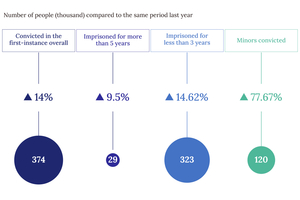In Depth: Rural China Suffers a Teen Mental Health Crisis
Listen to the full version
A new comprehensive report sheds light on the mental health challenges facing adolescents in rural China, a population that includes millions of “left-behind children.”
The term “left-behind child” refers to a rural child under 18 whose parents work away from home for at least six months, preventing them from living together. According to a 2023 report from the National Bureau of Statistics, about 10.9 million such children were enrolled in China’s compulsory education system in 2022.

Unlock exclusive discounts with a Caixin group subscription — ideal for teams and organizations.
Subscribe to both Caixin Global and The Wall Street Journal — for the price of one.
- DIGEST HUB
- Nearly 11 million rural “left-behind children” in China face high mental health risks, with 21.5% showing mild and 8.1% high depression risk in a 2024 survey of 13,992 students.
- Smartphone addiction is widespread, with 46.1% unable to tolerate being without a phone, worsening depression, especially among girls with weak family support.
- Systemic challenges—lack of trained staff, financial strain, poor facilities, and academic pressure—undermine mental health initiatives despite national policies.
A comprehensive new report highlights the significant mental health challenges experienced by adolescents in rural China, especially among the estimated 10.9 million “left-behind children”—those whose parents work far from home for at least six months, leaving them in the care of other relatives or alone[para. 1][para. 2]. A 2024 survey involving nearly 14,000 students across 18 poor counties in nine provinces, supported by the China Development Research Foundation, reveals that rural students face more pronounced difficulties than their urban counterparts. These include increased risks of depression, academic struggles, trauma, behavioral issues, and weaker positive psychological traits such as confidence and self-control. Of those surveyed, 21.5% were at mild risk of depression, with 8.1% at high risk[para. 3]. The lack of trained mental health professionals, poverty, bullying, and early boarding compound these mental health risks[para. 4].
Anecdotal stories like that of sixth-grader Song Xin, who is responsible for younger siblings and pressured by academic expectations while missing her parents, underscore the complex set of risks confronting these children[para. 5][para. 6]. Rural regions with high rates of left-behind children include Henan, Hunan, Sichuan, and Guangxi[para. 7].
Smartphone dependency has emerged as a major coping mechanism and risk amplifier. Teachers and parents recognize signs of late-night phone use, such as sleep deprivation and distraction in class[para. 10][para. 11]. The CDRF survey found that 46.1% of rural middle schoolers couldn’t tolerate being without their phone, while 43.8% constantly thought about it. This problematic usage is linked to higher depression risks, with eighth-grade girls being especially vulnerable[para. 13]. Attempts to restrict phone use at school are often ineffective, particularly when parental oversight is limited, as is common in left-behind families[para. 14]. School counselor Zhou Mei points out that phones fill an emotional void and compensate for a lack of alternative activities, leading to a damaging cycle of dependence and poor mental health; longer usage of short-video apps among rural youth correlates with greater depression and anxiety[para. 16][para. 17].
Family support is crucial in mitigating mental health risks. Children whose parents both work away from home are most vulnerable, particularly when communication and understanding are lacking; the risk of depression is seven times higher among those who feel misunderstood by their parents[para. 19]. Divorce or poor parental relationships further increase risks, and most students interviewed expressed loneliness and a longing for parental presence[para. 20]. Economic adversity is another driver—only 4.8% of the students consider their families well-off, 8.6% report financial hardship, and depression/anxiety risk is double among this group[para. 21]. Many rural schools lack basic sanitation, correlating with higher depression and bullying rates[para. 22]. Problematic behaviors like not doing homework, quarrelling, and emotional volatility are common, with hidden self-harm affecting as many as 22.8% of rural high schoolers[para. 24]. Academic struggles are both a cause and symptom of distress, leading some students to question the value of education altogether[para. 25].
Efforts to address these issues include a 2021 national mandate for school-based full-time counselors, though actual implementation lags in rural areas and the majority of counselors are part-time[para. 27]. Some school districts, like Jianghua in Hunan, have made progress after tragic events, training teachers as counselors and integrating mental health into curricula, which helped reduce bullying and conflict[para. 29][para. 31]. However, systemic challenges like academic performance-based evaluation for teachers and underfunded support services persist[para. 33][para. 35]. Experts conclude that technical fixes alone won’t suffice; a deeper investment in the dignity, welfare, and motivation of the most marginalized rural children is essential for improving mental health outcomes[para. 37].
- Beijing Chengying Charity Foundation
- The Beijing Chengying Charity Foundation conducted a survey of nearly 14,000 students in rural China, focusing on the mental health of "left-behind children." The foundation backs a report that highlights significant challenges, including higher depression risks, poorer academic adaptation, and behavioral issues among these students.
- CX Weekly Magazine

Aug. 29, 2025, Issue 33
- Discover more stories from Caixin Weely Magazine.
- Read More>>
- PODCAST
- MOST POPULAR






